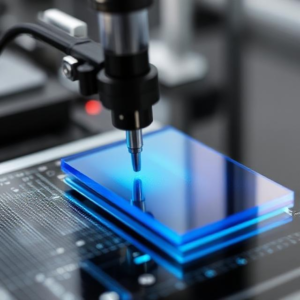Surface Physics and Surface Energy: Explained Simply
Surface physics is the study of the physical properties and behavior of materials at their surface, rather than in the bulk (the inner part of the material). This field is essential because the surface of a material often behaves differently from the rest of the material. Understanding surface properties is crucial for designing materials for everything from electronics to coatings.
One of the key concepts in surface physics is surface energy. It explains how atoms behave on a material’s surface and why certain surface properties are important for various applications.

What is Surface Physics?
Surface physics is the study of the properties of material surfaces, especially the interactions between atoms and molecules at the surface. In solids, the surface is where the material interacts with the environment, such as with air, water, or other materials. Because of this, the surface often has different physical and chemical properties than the material inside.
For example:
- The surface atoms of a material experience different forces than the atoms deep inside the material because they are not surrounded by other atoms on all sides.
- The arrangement of atoms at the surface may be less orderly, and there may be vacant spots or dangling bonds (atoms that are not bonded to other atoms in the same way as those in the bulk).
Surface physics focuses on understanding these behaviors and how they affect the material’s chemical reactivity, strength, thermal properties, optical properties, and electrical behavior.
Why Are Surfaces Important?
Surfaces are where many important interactions happen, such as:
- Chemical reactions: Many chemical reactions, like corrosion, catalysis, and adhesion, occur at the surface of materials.
- Optical properties: The way light interacts with the surface determines how materials look, how they reflect light, or whether they are transparent or opaque.
- Mechanical properties: Surface features can affect the strength or durability of a material. For example, rough surfaces might wear out more quickly than smooth surfaces.
What is Surface Energy?
Surface energy refers to the amount of energy that is required to create a new unit area of surface. It is a measure of the forces between the atoms or molecules at the surface of a material.
When you pull apart two pieces of a solid or break a liquid surface, you create new surface area. To do this, you need to overcome the forces holding the atoms or molecules together inside the material. The energy required to break these bonds and create new surface area is called surface energy.
In simpler terms, surface energy is like the “tension” or “stickiness” of the surface. The higher the surface energy, the more likely the surface is to interact with other materials (like adhesives, water, or other solids).
How Does Surface Energy Work?
At the surface of a solid, atoms or molecules are less tightly bound to each other because they are exposed to the environment (air, water, etc.). The atoms in the bulk (inside the material) are surrounded by other atoms, and their forces are more balanced. But at the surface, the atoms have fewer neighbors, so they have stronger bonds to the material and experience different forces than those in the bulk.
Example: Think of a bunch of people standing in a room. Most of the people (atoms) are surrounded by others, so they feel balanced and secure. But the people standing at the edges of the room (the surface atoms) are exposed on one side and feel less secure. They are the ones who experience more tension, and this is similar to how surface atoms behave.
Key Features of Surface Energy:
- Surface Energy and Adhesion:
- If a material has a high surface energy, it tends to adhere well to other materials. For example, if you put water on a material like glass (which has a high surface energy), the water will spread out, forming a thin layer.
- Conversely, materials with low surface energy, like wax or Teflon, tend to repel other materials and form droplets instead of spreading.
- Effect on Liquids:
- Water droplets form spherical shapes on surfaces with low surface energy (like wax). This happens because the surface energy of the material is lower than the surface tension of the water.
- On the other hand, water spreads out more on surfaces with high surface energy (like glass) because it can form stronger interactions with the surface.
- Surface Energy and Material Properties:
- High surface energy is often associated with materials that are chemically active or reactive. This is why metals, ceramics, and some polymers are used in catalysts or coatings.
- Low surface energy materials are less reactive and are often used for applications where you want to reduce friction or prevent sticking (e.g., non-stick cookware).
How is Surface Energy Measured?
To measure surface energy, scientists use a variety of methods, including:
- Contact Angle Measurement: This is one of the most common methods. When a drop of liquid is placed on a surface, the contact angle between the surface and the liquid drop is measured. A small contact angle indicates a high surface energy (the liquid spreads out more), while a large contact angle indicates low surface energy (the liquid forms a droplet).
- Surface Tension: The surface tension of liquids is closely related to surface energy. Materials with high surface tension (like water) also have high surface energy.
- Drop Test: Another method is to use a droplet of known liquid and observe how the liquid spreads across the surface. Based on this behavior, you can infer the surface energy.
Applications of Surface Energy
Understanding and manipulating surface energy is important in many fields:
- Coatings: Surface energy is crucial when applying paints, adhesives, and coatings. For example, a surface with low surface energy (like Teflon) is often used in non-stick coatings.
- Cleaning: Surfaces with low surface energy resist dirt and dust, which is why materials like hydrophobic coatings are used in cleaning products and devices.
- Biology and Medicine: Surface energy plays a role in biomaterials and drug delivery systems. It can help design materials that interact with cells or proteins in specific ways, which is useful for creating medical implants or targeted drug delivery.
- Electronics: Surface energy is important in the manufacture of semiconductors and microelectronics, where precise control of surface properties can affect performance and durability.
Summary of Key Points
- Surface Physics is the study of the physical properties of the surface of materials. The surface often behaves differently from the rest of the material due to the different forces acting on surface atoms.
- Surface Energy refers to the energy required to create a new unit area of surface. It is a measure of the “tension” or “stickiness” of the material’s surface.
- Materials with high surface energy tend to adhere well to other materials, while materials with low surface energy are more repellent.
- Applications of surface energy are seen in coatings, cleaning, medicine, electronics, and many other industries where surface interactions are crucial.
Surface energy explains why materials interact with liquids, adhesives, or other materials in specific ways. By understanding the surface physics of materials, scientists and engineers can design better coatings, improve adhesion, create advanced electronics, and even develop life-saving medical devices.











